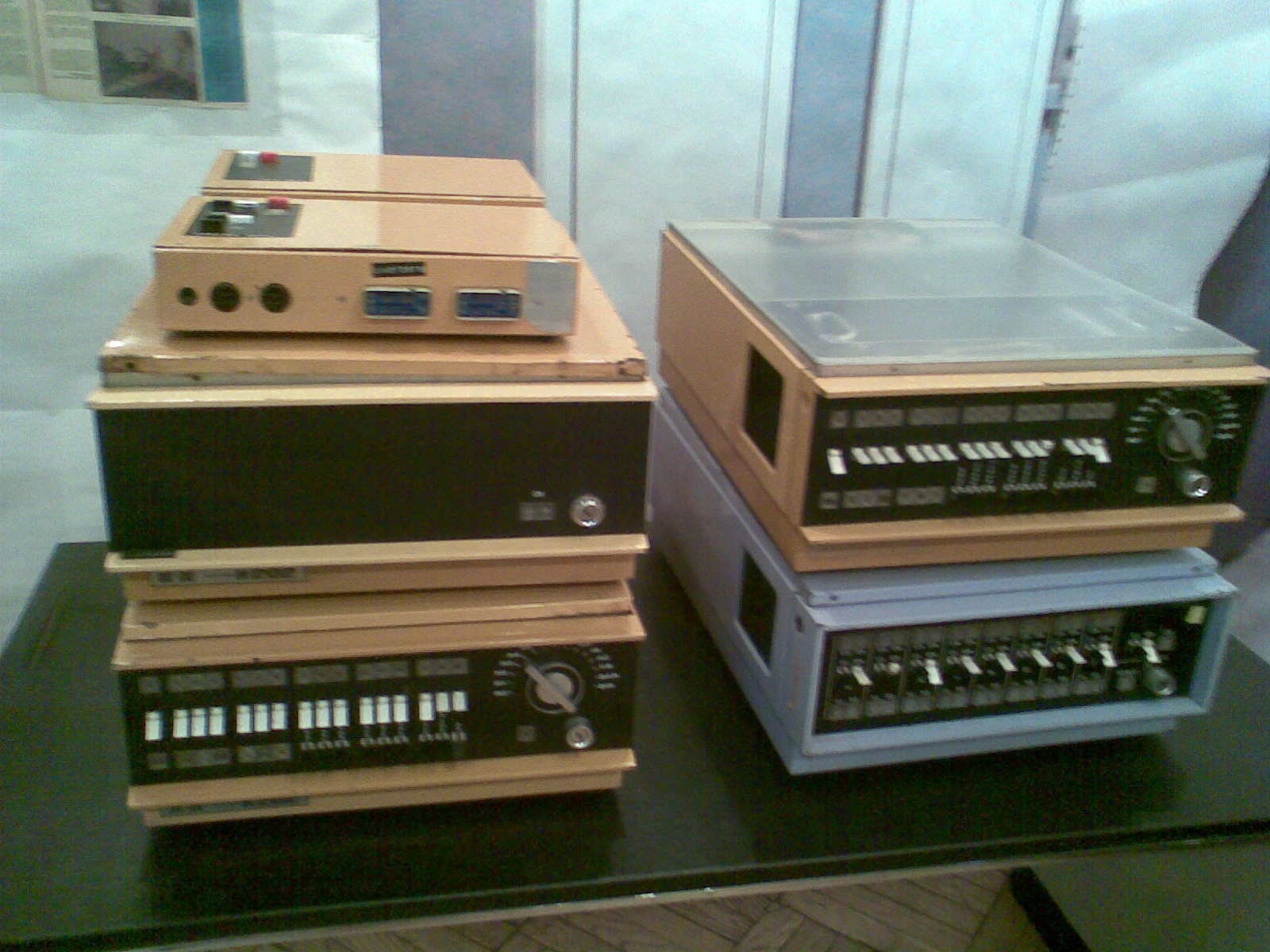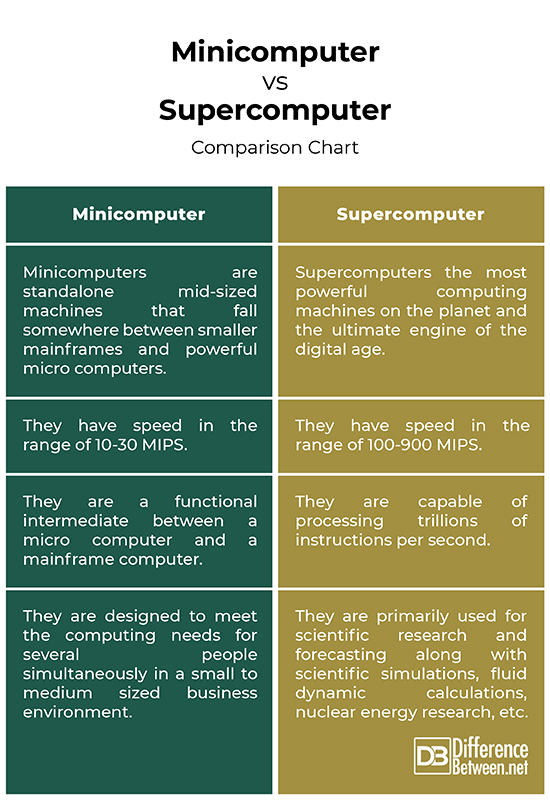Difference Between Minicomputer and Supercomputer
The computers are available in different shapes, sizes, processing capacity and performance. A computer used in a home is very different from the computer being used for business applications. According to capabilities, performance, and cost, computers can be easily classified as mini computers, super computers, mainframe computers, and micro computers. We are here to discuss only super computers and mini computers. Super computers are undoubtedly the fastest, most powerful and the most expensive type of computers with unparalleled processing capabilities and are primarily used for scientific research and forecasting. Mini computers are the medium-sized computers that can vary in power from a very large and powerful micro to small mainframes. Mini computers are sometimes called mid-range computers and are popular among medium sized companies. Supercomputers are the most powerful machines on the planet while mini computers are smaller mid-sized machines. Let’s take a look how the two differ in terms of speed and size, performance, and applications.

What is a Mini-Computer?
Mini computers are mid-sized computers that fall somewhere between smaller mainframes and powerful micro computers. They are a class of multi-user computers that can perform the same kind of tasks as a mainframe computer but have less storage capacity, processing power and speed than a mainframe computer but more than that of micro computers. Mini computers are a step down from mainframe computers when it comes to speed and storage capacity. In the early 1960s, Digital Equipment Corporation started shipping its PDP series computers, which the press described as mini computers because of their small size compared to other computers of the day. A mini computer is a small digital computer designed to meet the computing needs for several people simultaneously in a small to medium sized business environment. Basically, it is a functional intermediate between a micro computer and a mainframe computer.

What is a Super Computer?
Super computers, as the name suggests, are the most powerful computing machines on the planet and the ultimate engine of the information age known for their unparalleled processing capabilities. Supercomputers are at the top of the spectrum and are capable of processing trillions of instructions per second. The processing speed of a supercomputer is measured in floating point operations per second (FLOPS). Supercomputers have the highest processing speed at a given time for solving scientific and engineering problems. The processing speed of a supercomputer lies in the range of 400-10,000 millions of floating point operation per second (MFLOPS). Because of this, they are used in a wide range of applications. They have speed in the range of 100-900 MIPS. Supercomputers are capable enough to process a great deal of information and make extensive calculations rather quickly and efficiently. In 2003, India developed a supercomputer named PARAM Padma which marked an important step towards high-performance computing.
Difference between Minicomputer and Supercomputer
Size
– Mini-computers are standalone mid-sized machines that fall somewhere between smaller mainframes and powerful micro computers. They are the medium-sized computers that can vary in power from a very large and powerful micro to small mainframes. They are floor-standing or desktop machines, mainly connected to a mainframe computer to perform subsidiary operations. Supercomputers, on the other hand, are the most powerful computing machines on the planet with superior processing capabilities. Supercomputers are massive in size and can occupy few feet to hundreds of feet. They are a class of insanely powerful computers that can occupy a server room the size of two tennis courts.
Speed
– Supercomputers are the special purpose machines with unparalleled processing capabilities and can perform hundreds of millions of instructions per second. The processing speed of a supercomputer lies in the range of 400-10,000 millions of floating point operation per second (MFLOPS). They have speed in the range of 100-900 MIPS. They are the fastest computers available on the planet. Mini-computers, on the other hand, are mid-range machines with processing speed in the range of 10-30 MIPS. It’s a multi-user device capable of supporting up to hundreds of users simultaneously.
Functions
– Minicomputers serve as a centralized powerhouse for a cluster of workstations or as a network server. They are functionally intermediate between a microcomputer and a mainframe computer. Some minicomputers are uni-processor systems whereas some are multi-processor systems. They are ideal for use within a department in a college or university, or for use in a medium sized business environment. Supercomputers, on the other hand, are primarily used for scientific research and forecasting. They are used in fields that require vast amounts of complex mathematical calculations, scientific simulations, fluid dynamic calculations, nuclear energy research, and geological data analysis.
Minicomputer vs. Supercomputer: Comparison Chart

Summary
Mini computers are the medium-sized computers that can vary in power from a very large and powerful micro to small mainframes, and are popular among medium-sized business environment. They are floor-standing or desktop machines, mainly connected to a mainframe computer to perform subsidiary operations. Supercomputers, on the other hand, are the most powerful and the fastest class of computers on the planet with superior processing capabilities and are capable of processing trillions of instructions per second.
- Difference Between Caucus and Primary - June 18, 2024
- Difference Between PPO and POS - May 30, 2024
- Difference Between RFID and NFC - May 28, 2024
Search DifferenceBetween.net :
Leave a Response
References :
[0]Kamthane, Ashok N. Computer Programming: For Anna University. New Delhi, India: Pearson Education India, 2013. Print
[1]Behl, Ramesh. Information Technology for Management (Second Edition). New Delhi, India: Tata McGraw-Hill Education, 2012. Print
[2]Skeete, Kelvin. CXC Information Technology. Cambridge, United Kingdom: Cambridge University Press, 2004. Print
[3]Image credit: https://commons.wikimedia.org/wiki/File:Sierra_Supercomputer_(48002385338).jpg
[4]Image credit: https://commons.wikimedia.org/wiki/File:K-202_minicomputer.jpg
